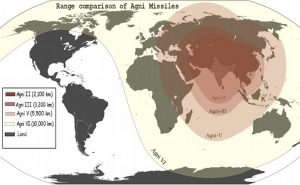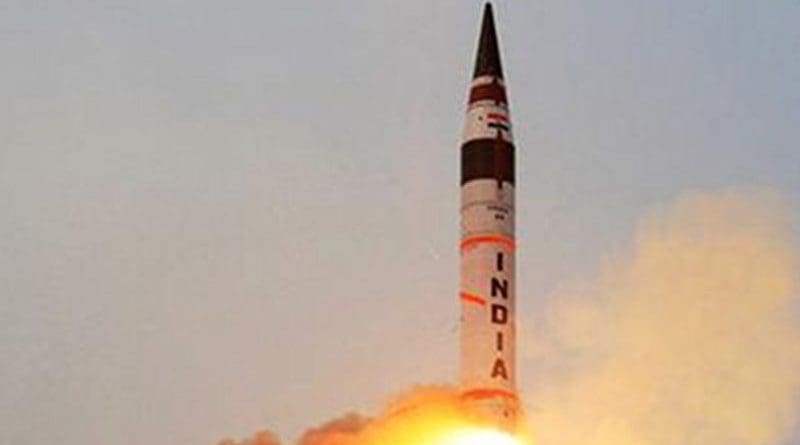What Recent Tests Reveal About India’s Missile Proliferation? – OpEd
MTCR is one of the four non-proliferation regimes that aim to curb missile technology that can be used for nuclear delivery systems. The other three are the Wassenaar Arrangement that deals with export control of dual use technologies and conventional arms. The Australia Group is related to export controls on technologies with regard to chemical and biological weapons. Lastly, the Nuclear Supplier Group (NSG) is a cartel of 48 countries that aims to curb proliferation of nuclear weapons.
The members participate in decision making and are expected to play their role in implementing the international standards for responsible non-proliferation behavior. It works with the International Code of Conduct against Ballistic missile proliferation (ICOC) in order to restraint the production and spread of delivery systems capable of delivering WMD.
India gained candidacy to MTCR which sets guidelines to control the production and delivery of missiles and unmanned aerial vehicles capable of mass destruction. The MTCR restricts its members to export missile or missile-related technology and systems capable of carrying a payload of at least 500 kg to a distance of at least 300 km. The decisions made in MTCR are consensus based. In past, the regime has been successful in convincing Argentina, Iraq and Egypt to give up their ballistic missile programs.
However, India’s entry in MTCR is being proved beneficial not only for India’s space and missiles program but it is also reinforcing its import export with other states possessing sensitive technologies without any vulnerability of facing sanctions. The significant improvement is the recognition of India’s nuclear legitimacy that will strengthen its credentials. It has been the quest of Indian strategic planners to be the members of elite nuclear clubs; therefore the candidacy to MTCR may help India in its ambition to join NSG and get the permanent seat in United Nations Security Council (UNSC). The 37th Plenary meeting of NSG will be held in June this year and this is yet to see if India would bargain for its inclusion in NSG with China, which has been rejected for MTCR’s membership in 2004. As now India will be in position to help China’s inclusion in MTCR. Last year, China protested India’s membership in NSG as non-NPT state but at that time India was not the member of MTCR.
MTCR Membership Helping India’s Missile Program

The MTCR membership is profoundly helping in India’s missile program. Previously India was denied sophisticated missile technology due to MTCR provisions standards or sanctions. Now when all these limitations have been removed, India is extending its missile’s ranges to improve its defense and striking capabilities. Other than missiles, India is now importing surveillance drones from US, before denied due to MTCR restrictions. On the other hand, Indian approval for acquiring Arrow II theatre missile defense interceptor from Israel was facing constant delay because the acquisition was subject to US approval. The US was bound to abide by the MTCR guidelines thus despite the willingness of Israel this technology transfer could not take place. But recently, Israel Aerospace Industries (IAI) announced the biggest security contact ever to supply long range air and missile defense systems.
Moreover, India’s space program was also facing setback because it was unable to export cryogenic technology from Russia. The technology was also required to expedite India’s Agni’s program and ICBM pursuit. In the next year after India joined MTCR, it successfully tested Agni-V which ranked India among few states possessing Inter Continental Ballistic Missile (ICBM). India also developed capability to launch manned space missions. However the field of drone technology is being benefitted in the absence of confines after this regime’s membership and now India is looking forward to export drone’s technology from US.
To conclude, the admission to MTCR largely proved beneficial to India in order to improve its offensive-defensive capabilities. The country is now extending its missile ranges which are helping the rationale of missile proliferation. Most of these capabilities might not be directly aimed at Pakistan yet the trend to develop variety of capabilities can allow India to adopt an aggressive strategy towards Pakistan in future. The fearsome aspect is that a debate has already been stirred up in strategic and policy circles about India reviewing its no-first policy. The signs of internal debate to reconsider nuclear posture and the acquisition of diverse along with missile proliferation will adversely impact the South Asian strategic stability.
*Maimuna Ashraf is a member of an Islamabad based think tank, Strategic Vision Institute (SVI). She works on issues related to nuclear non-proliferation and South Asian nuclear equation. Furthermore, she regularly writes for national and international dailies.


Violation of MTCR is not new phenomena. India is guilty of assisting North Korean nuclear scientists. Despite UN strict rule, India helped North Korean Scientists. Unfortunately, India has not provided logical and plausible explanation for its violation.
India seems to be constantly engaging itself in pursuing the development of new nuclear-capable missiles that risk further escalating tensions in South Asia and increasing the chance of a nuclear exchange. Despite of the afct that India is a signatory to MTCR it is still involved in stuffing up the region with new and sophisticated delivery mechanisms thus raising insecurities in the region and making both China and Pakistan conscious and vigilant enough to react to these developments in orer to serve their own interests. The writer is very much true in highlighting the very phenomenal change in India’s nuclear policy viz a viz its developing missile program.
From 1946-2012, the US has been the biggest donor of economic aid to India besides facilitating its nuclear expansion; it does not seem to realise the threat that the India missile programme poses to its interests. In future India could assume a confrontational stance against it over Middle East oil or side with Russia in a conflict, or even confront Russia over Central Asia. Likewise, the India Rapid Reaction Cell: the US must rethink its policies before it is too late, or else it will have to set up another special cell called ‘How to contain India?’